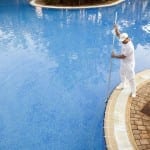 Hurricanes can do a lot of damage to your pool if you’re not properly prepared. Similarly, properly reactivating your pool can save you some trouble in the longterm. Use these storm preparation and pool reactivation tips from the Florida Swimming Pool Association to get your pool ready, and most importantly, stay safe!
Hurricanes can do a lot of damage to your pool if you’re not properly prepared. Similarly, properly reactivating your pool can save you some trouble in the longterm. Use these storm preparation and pool reactivation tips from the Florida Swimming Pool Association to get your pool ready, and most importantly, stay safe!
Storm Prep
1. Do not drain your pool. The water in your pool provides weight to hold the bottom and sides in place when heavy rains raise the water table. If you empty your pool, you risk the possibility of lifting your pool off it’s foundation.
2. Maintain your water level or decrease by 1-2 feet. If your pool has working drains and skimmers and the area around the pool offers drainage, you can keep your normal water level. If the area surrounding the pool doesn’t drain properly and could be damaged, lower the water levels by a foot or two.
3. Shock your pool. While FSPA recommends super chlorinating your pool or shocking as normal, if you have a Clear Comfort pool, you could also opt for a non chlorine shock to avoid adding chlorine to the water.
4. Turn off automatic equipment/electrical. Turn off all electric power at the circuit breaker before the storm. If you anticipate flooding, disconnect and store electrical equipment. Otherwise, cover it tightly with plastic.
5. Create a vent in your screen. If your pool is enclosed in a screened area, you can create a vent for wind to pass through to avoid damage to the screen and structure.
6. Store pool furniture. Remove all loose objects including toys, chairs, tables and pool equipment that can become dangerous in fierce wind. If you don’t have a place to store them indoors, you may place them in the pool, knowing that water and pool chemicals can damage them.
After the Storm
1. Again, do not drain your pool. After a storm, the water table may have risen and emptying your pool could damage your pool’s foundation. Similarly, you don’t need to lower the water unless you are having problems with drainage.
2. Test your water. First, test your pool. If needed, you may opt for a non chlorine shock to recover the water chemistry or super chlorinate.
3. Dry equipment. Dry all equipment before turning power back on and plugging equipment in. Follow manufacturers’ instructions for safety.
4. Monitor automated systems. Watch to ensure you reset timers and other automated systems properly.
5. Remove debris. Clean the pool of debris with a net or skimmer. Do not use your pool vacuum, since it is likely to clog.
Leave a Reply